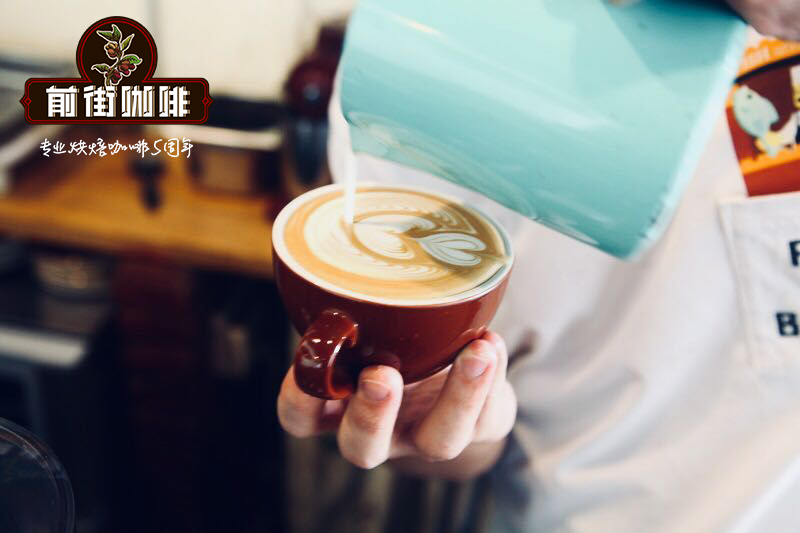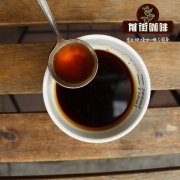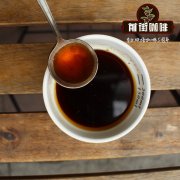What are the well-known varieties of coffee beans grown in Brazil? What's so special about hand-made Brazilian coffee beans?

Professional coffee knowledge exchange more coffee bean information please follow the coffee workshop (Wechat official account cafe_style)
What kind of coffee beans are grown in Brazil with huge production? What's the special flavor of hand-made Brazilian coffee beans?
The total output of the top in the world
When it comes to the leading producing area of the coffee industry, there is no doubt that it is South America and Brazil. Its coffee production accounts for about 1/3 of the world's total output, with an average annual export volume of 2m-30m bags of 60 kg coffee beans. It is not only the most extensive country in South America, but also the world leader in output. Also in the Golden Coffee Belt, South America has ─ Colombia, the second largest coffee exporter in the world. Although Colombia produces more than twice as much as Brazil, it still accounts for about 15% of global production, and the quality is stable because it produces only Arabica coffee beans.
In terms of flavor, generally speaking, coffee beans in South America are neutral and the flavor is more supple. Brazilian coffee tastes smooth and mild, can be tasted individually, and is also suitable for adding milk to make fancy coffee such as latte and cappuccino, which is widely used for blending. In contrast, Colombian coffee has a strong aroma and moderate bitterness. It is not only recommended to drink as a single product, but also commonly used in coffee blending to increase the sweetness of coffee and neutralize the bitterness of other coffees. As a result, South American coffee is a special favorite flavor of Asians.
Brazilian Coffee Association and CoE Competition
In 1991, Brazil established the Coffee Association to improve the quality of extremely hard beans comparable to that at high altitude, and with the assistance of the American Fine Coffee Association (SCAA), held the first Brazilian extraordinary Cup Coffee Competition (Cup of Excellence) in 1999. After years of witness and guidance by international cup testers, the flavor gradually gained public recognition, and also broke away from the stereotype of Brazilian coffee without fine products.
The characteristics of Brazilian coffee
Brazilian coffee generally refers to coffee produced in Brazil. There is a wide variety of Brazilian coffee, the vast majority of which are unwashed and sun-dried, classified according to the name of the state of origin and the port of transport. Brazil has 27 states and 17 states produce coffee, but four of them produce the largest, accounting for 98% of the country's total output. The taste of Brazilian coffee has a low sour taste, with the sweet and bitter taste of coffee, the entrance is very smooth, but also with a hint of grass aroma, slightly bitter in the fragrance, smooth and smooth, with a pleasant aftertaste.
The origin of Brazilian coffee
Brazilian coffee generally refers to coffee produced in Brazil. There are many kinds of Brazilian coffee, and like other Arabica coffee, Brazilian coffee is called "Brazils" to distinguish it from "Milds" coffee. The vast majority of Brazilian coffee is unwashed and sun-dried and is classified according to the name of the state of origin and port of transport. Brazil has 27 states, 17 of which produce coffee, but four of them produce the largest, accounting for 98 per cent of Brazil's total output: Parana, SaoPaulo, MinasGerais and EspiritoSanto, with the southern state producing the most, accounting for 50 per cent of total production.
Brazilian coffee is a low-acidity, moderately roasted coffee bean from the World Coffee Center. As a kind of high-quality coffee, Brazilian coffee can be drunk individually or mixed.
The characteristics of ● taste: mild, bitter medium, soft flavor.
The best fried culture degree of ●: medium fried culture.
The taste of Brazilian coffee has a low sour taste, with the sweet and bitter taste of coffee, the entrance is very smooth, but also with a hint of grass aroma, slightly bitter in the fragrance, smooth and smooth, with a pleasant aftertaste. There are no outstanding advantages for Brazilian coffee, but there are no obvious defects. The taste is mild and smooth , low acidity, moderate mellow, and a touch of sweetness. All these soft flavors are mixed together. To distinguish them one by one is the best test for taste buds. This is also why many Santos fans love this kind of coffee. It is precisely because it is so mild and ordinary. Santos is suitable for ordinary baking, suitable for brewing in the most popular way, and is the best raw material for making Italian espresso and all kinds of fancy coffee.
One of the most famous is Sandos Coffee, which tastes mellow and neutral. It can be boiled directly or mixed with other kinds of coffee beans to form a comprehensive coffee. It is also a good choice.
Other kinds of Brazilian coffee, such as Rio and Parana, can be produced in large quantities because they do not require too much care. Although the taste is rough, it is a kind of high-quality and inexpensive coffee, which has its own standards because it is distributed all over Brazil and varies in quality (NO.2--NO.8 according to the number of sundries, NO.13--NO.19 according to the size of beans, and six grades according to taste). Almost all Arabica varieties are of good quality and stable in price. The most famous one is "Brazil Santos", which has been a necessity of blended coffee and is familiar to the public since ancient times. Recently, the "Guilma Cup" is also highly rated.
Varieties of Brazilian coffee
Although coffee is diverse, Brazilian coffee is suitable for the taste of the public. For example, coffee produced in the northern coastal areas has a typical iodine taste, reminiscent of the sea after drinking. This coffee is exported to North America, the Middle East and Eastern Europe. Another kind of coffee that is interesting and worth looking for is washed Bahia. This kind of coffee is not easy to find because Brazil is the world's largest consumer of coffee after the United States, and many of the best coffee can only be found in its domestic market.
In Brazil, the largest producer is Robbins. This coffee is sold in the Super market. Brazil Robbins Coffee with Cornilon (
Conillon) is sold under the name, accounting for 15% of total production.
The old bourbon coffee is grown on some estates in the Serrado district of MinasGreais in southeastern Brazil. These estates, such as Caping Blanco (CapinBranco) and Vista Allegre (VistaAllegre), grow old varieties of bourbon coffee on the market. Although they come from the same area, these coffees have their own characteristics. Capingblanco coffee is smoother than Vesta Allegre coffee, while Vesta Allegre coffee is strong and black, both of which have lower acidity. However, like all Brazilian coffee, they are most suitable for drinking when they are fresh and tender, because the older they are, the more acidic they are. These coffee growers have organized themselves into the Brazilian Special Coffee Association (theSpecialityCoffeeAssociationofBrazil).
Brazil is figuratively compared to the "giant" and "monarch" of the coffee world. There are about 3.97 billion coffee trees there, and small farmers now grow 75% of Brazil's total coffee production. The number of coffee producers in Brazil is twice or even three times that of Colombia, the second largest coffee producer in the world.
In terms of natural conditions, Brazil is in the tropics, with a tropical rain forest climate in the north, hot and humid all the year round, suitable for tropical crops, coffee trees are sunny crops, and sufficient sunlight is the condition for their growth. Historically, Brazil has been a Portuguese colony for a long time. In order to meet the needs of Western Europe, it has planted single crops for a long time and developed the tropical plantation economy, so Brazilian coffee has been its pillar industry for a long time. From the market point of view, coffee and its processed products are rich in caffeine, exhilarate and play an important role in the working group dominated by mental workers, so they play a huge role in modern society, so the market is broad. Taken together, Brazil ranks first in coffee production in the world.
Unlike in the past, Brazil's economy is less dependent on coffee, which accounts for only 8% of GDP and 10% of GDP. Before World War II, Brazil accounted for 50% or more of the world's coffee production, and now it is close to 30%. But the country's impact on the world's coffee, especially on coffee prices, is significant. For example, two frost disasters in 1994 caused a sharp rise in global coffee prices.
Since the introduction of coffee trees from French Guiana (Guyana) in 1720, coffee production has gradually become a science. Before 1990, the Brazilian government carried out strict monitoring of the coffee industry, with both strict intervention and price protection measures, and the state has been implementing minimum price protection measures for farmers, resulting in coffee overproduction. Before World War II, the remaining stock reached 78 million bags, which had to be burned by fire or thrown into the water to destroy.
Since the opening of the free market in 1990, the original Brazilian Coffee Authority (IBC) has been replaced by the National Economic Association, the country's non-investment administrative body, which pursues a policy of non-intervention and allows producers to negotiate directly with exporters. The business activities of exporters are supervised by the government legislation, and the relevant departments register legitimate exporters.
The largest coffee producer, which accounts for 1/3 of the world's coffee consumption, accounts for 1/3 of the world's coffee consumption and has a place in the global coffee market, although Brazil faces several times more natural disasters than other regions. but its acreage is enough to make up for it.
There are many kinds of coffee here, but its industrial policy is large and cheap, so there is not much premium coffee, but it is a good choice for mixing other coffees.
Qianjie cuisine is recommended:
V60 filter cup, 15g powder, water temperature 90 degrees, grinding 3, water powder ratio close to 1:15
Steaming in 30 grams of water for 30 seconds
Section: inject water until 110ml is cut off, wait for the water level to drop to 1pm 3 and then slowly inject water until 225ml stops.
The acidity of the washed Yega Chuefei will be brighter, like citric acid, with a more delicate taste, a more obvious citrus flavor and a bit of tea in the latter part.
Other suggestions for trickling extraction:
Normal pressure, recommended grinding degree of 3.5-4 / water temperature 90 °C
Philharmonic pressure, recommended 2.5 grinding degree, water temperature 90 °C
Hand punch: 3.5 degree of grinding, water temperature 91 °C
3.5 Grinding-90 degrees water temperature
Important Notice :
前街咖啡 FrontStreet Coffee has moved to new addredd:
FrontStreet Coffee Address: 315,Donghua East Road,GuangZhou
Tel:020 38364473
- Prev

The flavor characteristics of Brazilian pectin sun-cured coffee beans with huge production? How to cook Brazil Santos by hand
Professional coffee knowledge exchange more coffee bean information please follow the coffee workshop (Wechat official account cafe_style) the huge output of Brazilian pectin sun-cured coffee beans flavor characteristics? How to brew Brazilian Santos coffee by hand? The largest coffee producer, all grades and types of coffee accounts for 1/3 of the global consumption, and occupies a place in the global coffee market.
- Next

The story of Guatemalan coffee cultivation the flavor of orange honey treatment at St. Felicia Manor in Akatilan?
Professional coffee knowledge exchange more coffee bean information please follow the coffee workshop (Wechat official account cafe_style) the story of Guatemalan coffee cultivation the flavor of orange honey treatment at Acatilan San Felicia Manor? How can it be cooked to taste good? Finca Santa Felisa, a famous organic coffee garden in Guatemala, is founded by Trinidad E. Cr.
Related
- Detailed explanation of Jadeite planting Land in Panamanian Jadeite Manor introduction to the grading system of Jadeite competitive bidding, Red bid, Green bid and Rose Summer
- Story of Coffee planting in Brenka region of Costa Rica Stonehenge Manor anaerobic heavy honey treatment of flavor mouth
- What's on the barrel of Blue Mountain Coffee beans?
- Can American coffee also pull flowers? How to use hot American style to pull out a good-looking pattern?
- Can you make a cold extract with coffee beans? What is the right proportion for cold-extracted coffee formula?
- Indonesian PWN Gold Mandrine Coffee Origin Features Flavor How to Chong? Mandolin coffee is American.
- A brief introduction to the flavor characteristics of Brazilian yellow bourbon coffee beans
- What is the effect of different water quality on the flavor of cold-extracted coffee? What kind of water is best for brewing coffee?
- Why do you think of Rose Summer whenever you mention Panamanian coffee?
- Introduction to the characteristics of authentic blue mountain coffee bean producing areas? What is the CIB Coffee Authority in Jamaica?

